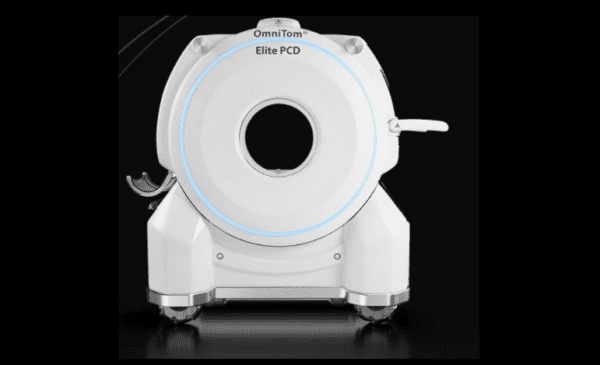|
NeuroLogica’s PCCT | Seeking AI Complements
March 13, 2022
|
|
|

|
|
Together with
|

|
|
|
“Anecdotally, I have seen more success for health tech products which enable a healthcare professional to do something they don’t normally do, rather than attempt to replace what they already can do.”
|
|
A tweet from Hardian Health’s Dr. Hugh Harvey.
|
|
|
Happy 400th Imaging Wire issue, everyone. We’re super grateful for all of the readers, sponsors, friends, and family who’ve made Insight Links & The Imaging Wire possible.
Enjoy today’s newsletter 🙂
|
|

|
|
Samsung’s NeuroLogica subsidiary announced the FDA 510(k) clearance of its photon counting-based OmniTom Elite PCD, significantly expanding the mobile head/neck CT system’s diagnostic potential and adding to photon counting technology’s recent momentum.
About the OEPCD – The OmniTom Elite with PCD is now available as an optional upgrade (including field upgrades), swapping the standard OmniTom Elite’s energy integrating detector (EID) for a single-source cadmium telluride-based photon counting detector. Beyond the OmniTom Elite with PCD’s imaging advantages (2x higher spatial resolution, spectral CT images at multiple energy levels), all other key features are shared between the two configurations (16 row, 40cm bore, 30cm FoV).
The Photon Counting Race – NeuroLogica’s photon counting CT launch comes about six months after Siemens Healthineers’ NAEOTOM Alpha became the first FDA-cleared PCCT. The OmniTom Elite with PCD’s launch also comes amid major R&D and M&A efforts from essentially all major OEMs, as they compete for photon counting CT leadership.
The Photon Counting Advantage – Those efforts seem warranted, as PCCTs produce far higher quality images and provide far more imaging data, while potentially allowing lower radiation exposure and contrast dosage. For the OmniTom Elite’s head and neck applications, that could mean improved visualization and segmentation of bones, blood clots, plaques, hemorrhages, and intracranial tumors.
NeuroLogica’s Next Steps – Even if photon counting’s advantages are widely agreed upon, its potential clinical applications are still being explored. Because of that, NeuroLogica’s announcement emphasized ongoing research efforts to evaluate the OmniTom Elite with PCD’s performance with certain patients (e.g. post-trauma and post-surgical patients) and its plans to develop the mobile PCCT’s “full potential.”
The Takeaway
The OmniTom Elite PCD’s head/neck imaging design (vs. whole body) and use of a single-source detector (vs. dual) make it quite different from the other PCCTs being developed, but it’s launch is still a notable milestone for photon counting CT technology. It’s also a testament to Samsung/NeuroLogica’s R&D efforts, coming 4.5 years after showing the detector at RSNA 2017, and reaching the market before most of the biggest CT players released their own PCCTs.
|




|
|
RadNet on The Revolution Maxima’s Patient Centered Care
See how GE Healthcare’s Revolution Maxima CT optimizes care by keeping technologists closer to the patient in this testimonial from RadNet’s Lawrence Tannenbaum, MD.
|
|
Ramapo Radiology’s Case for Novarad CryptoChart
See how New Jersey’s Ramapo Radiology Associates overcame their CD burning problems and improved their physician and patient experiences with Novarad CryptoChart.
|
|
- AI Needs Complementary Innovations: The Brookings Institution added to 2022’s growing list of editorials about “what healthcare AI needs,” suggesting that AI will require a series of “complementary innovations” to achieve widespread adoption. Looking back at previous medtech adoption milestones (e.g. EMRs needed software integration innovations), the authors argued that widespread AI adoption will require innovations targeting algorithm acceptance/performance (adding trust and interpretability), training data availability (easier collection), easing regulatory barriers (new regulations for privacy, approval, liability, data ownership), and decisionmaker incentive alignment (no specific suggestions).
- Siemens & Cerebriu’s Brain MR Alliance: Siemens Healthineers and Danish AI startup Cerebriu announced an R&D partnership and future plans to integrate Cerebriu’s Smart Protocol for Brain software with Siemens’ MRI systems. The Cerebriu software adapts MRI scanning protocols during image acquisition, making adjustments that support personalized imaging, differential diagnosis, and scanning efficiency.
- Cancer Research Inequalities: A new Clinical Imaging study revealed that the volume of imaging research focused on certain cancers can be far higher or lower than their incidence and mortality rates would suggest. Analysis of 620 cancer imaging studies showed that central nervous system and liver cancers might be overinvestigated (publication-to-incidence ratio >2), whereas nonmelanoma of the skin, leukemia, stomach cancer, and laryngeal cancer appear underinvestigated (publication-to-incidence ratio <0.2).
- Intelerad’s Enterprise Suite: After several years of ambitious acquisitions, Intelerad Medical Systems is bringing its acquired technologies together in its new Enterprise Imaging and Informatics Suite. The new Enterprise Suite gives hospitals and health systems an integrated system that combines Intelerad’s IntelePACS with the Clario SmartWorklist vendor-neutral worklist, an Enterprise VNA, and the Ambra Image Exchange. The Enterprise Suite can also integrate with Intelerad’s Cardiovascular Suite (w/ CVIS and CV tech from Digisonics, HeartIT, and LUMEDX,) and its Life Sciences Suite.
- Sonosite vs. Butterfly: Fujifilm Sonosite filed a patent infringement lawsuit against Butterfly Network, alleging that the Butterfly iQ/iQ+ handheld ultrasound systems infringe on seven Fujifilm patents related to point of care ultrasound acquisition (e.g. using a probe w/ a mobile device, graphical interface elements, image processing).
- Brain MRI Unnecessary For NSCLC: A new Radiology Journal study suggests that performing brain MRI in asymptomatic patients with early-stage non–small cell lung cancer (NSCLC) has no impact on survival and is likely unnecessary. The study looked at 628 patients from 2009-2016, of which 53% received a staging brain MRI. The brain MRI exams did not appear to have prognostic benefits for brain metastasis-free survival, time to brain metastasis, or overall survival.
- Medimaps’ TBS Codes: Medimaps announced CMS’s addition of new codes for DXA and X-ray-based Trabecular Bone Score assessments ($41.53 w/ PFS, $82.61 w/ HOPPS). The new codes could have quite an impact on TBS procedure volumes (currently 600k in the US annually), perhaps explaining why Medimaps recently raised $20M to fund an upcoming commercial expansion.
- Pediatric Radiation Reductions: A new Insights into Imaging study detailed a Brazilian pediatric radiation reduction campaign that cut imaging referrals by 25% across 19 healthcare facilities. The campaign (launched in 2016) involved forming a radiological protection committee, distributing educational materials (banners, folders, videos) and referral guidelines, and creating personal dose cards for each patient.
- Clarius’ New Funding & Leaders: Clarius Mobile Health is heading into spring 2022 with a new leadership team, $20M in new funding (total now $45M), and a reinforced global commercialization strategy. The handheld ultrasound startup named imaging veteran Ohad Arazi as its new president and future CEO (formerly of Zebra-Med, TELUS, and Change/McKesson), while appointing Don Listwin as Board Chair (formerly Rapid AI CEO), and transitioning founder Laurent Pelissier from CEO to Chief Innovation Officer.
- MRI Claustrophobia: A new UK-based study revealed that nearly 1% of patients are unable to complete MRI exams due to anxiety or claustrophobia (0.8%, n= 678k exams), although factors such as demographics and scanner type play an important role. Female patients were 25% more likely to end scans early due to claustrophobia, while patients between 45-64 years of age were 25% more likely than the average patient to end scans early. The majority of scans were performed on conventional systems, but patients undergoing Open MRI scans were 3x more likely to fail a scan and patients receiving UpRight scans were half as likely to fail.
- RefleXion Adds $80M: RefleXion Medical added another $80M in equity financing to its massive fundraising total (now at least $445M) as it continues to scale its biology-guided radiotherapy (BgRT) system to new cancer types and stages. The BgRT system combines FDG PET with an integrated linear accelerator radiotherapy system, which could potentially allow it to target all visible cancers simultaneously (vs. one or two).
|
|
Imaging AI’s DLIR Future
Check out this talk from Eliot Siegel, MD on the “Hype, Myth, Reality and Next Steps” of imaging AI, including a profile on Canon’s AiCE Deep Learning Reconstruction solution at around the 4-minute mark.
|
|
Us2.ai Automates the Fight Against Heart Disease
See how Us2.ai cuts echocardiography’s manual work, subjectivity, and turnaround times to automate the fight against heart disease.
|
|
- Join Microsoft and Nuance on March 24th at 2pm ET to learn how they are working together to develop Nuance’s next‑generation, AI‑powered diagnostic imaging platform.
- Over 9 out of 10 people who should be screened for lung cancer aren’t, and nearly 50% of lung cancer cases are caught in the advanced stages. We know from prostate and breast cancer screening that clear guidelines and increased screening saves lives. But lung cancer screening has been challenging. Riverain strives to make everything about the lungs clearer, so they assembled this resource page for anyone interested in starting or improving their lung screening program.
- With radiologist workloads growing in volume and complexity, having the wrong PACS can lead to radiologist burnout. This helpful Fujifilm post shows how having the right PACS that functions as a centralized and integrated enterprise imaging system can be part of the solution.
- Check out this Imaging Wire Show, featuring Nanox AI strategy leader, Dr. Orit Wimpfheimer, where we discuss building an international telerad practice, what’s wrong with triage AI, and pivoting to population health AI.
- With radiation dose management now largely considered best practice, this Bayer white paper details the top five benefits of adopting contrast dose management.
- Variable heart rates and organ motion can make cardiac imaging a challenge for CT technologists. Discover how intelligent imaging guidance with Siemens Healthineers’ myExam Companion can help overcome these challenges, without compromising quality and consistency.
- Imaging Wire readers have been following along as Intelerad created a truly comprehensive Enterprise Imaging and Informatics Suite. Here’s how to see it in person at HIMSS 22.
|
|
|
|
|